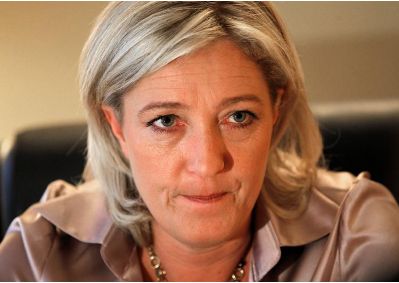By Eric Vandenbroeck
and co-workers
How To Understand Extreme Right-Wing
Parties
While everybody has
been watching how Nancy Pelosi's husband was attacked with a hammer
and his skull broken while the attacker kept screaming, "Where
is Nancy? Where is Nancy?" Among the many takeaways of the U.S.
midterms, one of the most striking is the alarming number of election deniers
on the ballot, often in uncontested districts. Across the country, dozens of
candidates for House, Senate, and state-level positions who have refused to
recognize the 2020 election results are coming to office. As such, they are the
latest signs in what some observers see as a dangerous democratic decline
across the West. According to this view, what has happened in the United States
since January 6, 2021, assault on the Capitol has found echoes in Western
Europe, where far-right parties recently achieved stunning success in Italy and
Sweden and shown new strength in France.

Witnessing this
trend, commentators are consumed by fears that, as the nonprofit group Freedom
House puts it in its latest global survey, “around the world, the enemies of
liberal democracy … are accelerating their attacks.” Just as many see a large
number of election deniers, conspiracy theorists, and insurrection trivializers
in the Republican party as evidence of the erosion of long-held democratic
norms, they see the victories this fall of the Brothers of Italy and the Sweden
Democrats, parties with far-right roots, as a sign that fascism is returning.
Democracy is imperiled—even in Western Europe, where it has long been taken for
granted.
Giorgia Meloni in Italy:


But this doomsday
view overlooks the varied political contexts in which these developments play
out. There are many reasons to worry about far-right movements, particularly
when they deny election results or otherwise seek to undermine democratic
institutions. But there are crucial differences between what has happened in
some European countries, where once far-right parties have moderated over time,
and the United States, where one of the mainstream parties has embraced
far-right, anti-democratic ideas. Indeed, rather than showing that European
democracy is endangered, the evolution of the Brothers of Italy and the Sweden
Democrats offers reasons for cautious optimism. Like many other right-wing
parties in Western Europe, these have extremist roots but have recognized that
winning votes and political power requires moving away from those roots,
moderating their appeals and policy platforms, and pledging to adhere to
democratic norms.
Marine Le Pen, France's
far-right National Front:

The evolution of the
Brothers of Italy, the Sweden Democrats, and other Western European right-wing
populist parties reflects something critical but counterintuitive about the
relationship between extremism and democracy. Whether extremist groups will become
significant threats to democracy depends less on the groups themselves and more
on the nature of the democracies in which they emerge. When democratic norms
and institutions are weak, extremists may have little incentive to moderate
since they can gain supporters and even actual power without playing by the
rules. But where democratic norms and institutions are strong, extremists will
be forced to moderate because there will be a little constituency for
explicitly antidemocratic or radical appeals and because if they don’t, other
political actors and institutions will be able to keep them from power in any
case.
"Sweden Democrats"

This dynamic directly
affects how threats to democracy can be managed, including in the United
States. Moreover, while unfolding political events can be hard to judge
dispassionately, radical or extremist political movements have challenged
democracy on numerous past occasions. These can be evaluated with the benefit
of hindsight. A particularly illustrative case is the fate of communist parties
in Western Europe during the interwar period and after World War II. During
these decades, the political systems of European countries faced large-scale
changes—whether toward or away from democracy—and examining the course of those
events offers insight into the factors that shaped these parties’ behavior.
Nasty And Brutish

Although interwar
Europe is primarily remembered for the rise of fascism and Nazism, democracy
during this time was also challenged by the left. After 1917, the Russian
Revolution triggered the formation of revolutionary, insurrectionist, and
anti-democratic communist parties in almost every European country. In Italy,
the party that initially had the greatest strength, the Italian Socialist
Party, had little interest in democracy. It cheered the endless riots, strikes,
and insurrections plaguing the country. Taking an even harder line, some
socialists broke away to form the openly revolutionary Italian Communist Party
(PCI) in 1921, which soon increased its insurrectionary activity and helped to
dismantle Italian democracy. Indeed, at the PCI’s 1922 congress, party leader
Amadeo Bordiga focused on the need to fight social
democracy rather than fascism, even though the Fascist Party was only months
away from being handed power.
Similarly, in
Germany’s Weimar Republic, the Communist Party (KPD) consistently attracted
around 10–15 percent of the vote and maintained an armed militia engaged in
street brawls and insurrections. When the Great Depression caused chaos in
Germany during the early 1930s, the KPD’s vote share grew, as did its violent
and anti-democratic activity. Indeed, so eager was the KPD to hasten the
republic’s downfall that it joined with the Nazis in September 1932 in a vote
of no confidence, toppling the existing government and ushering in the election
in November that would bring Hitler to power.

Crucial to these
developments was the weakness of European democracy in this period. In addition
to being unable to respond to the demands of their citizens, many governments
were unable to prevent communists and other extremists from fielding private
militias and engaging in extraparliamentary activity.
At the same time, in many countries, liberal parties collapsed, and the other
main forces capable of defending democratic institutions—social democratic and
socialist parties—proved unable or unwilling to do so. Without governments able
to enforce the democratic rules of the game and other parties able to make
extremists pay the price for anti-democratic behavior, communists and their
right-wing counterparts had few incentives to moderate their behavior.
Less Lenin, More Aristotle
When the dust cleared
at the end of World War II, communist parties reemerged in many Western
European countries. In many cases, these parties received even more support
than they had before the war because of the communists’ heroic wartime
resistance and the prestige enjoyed by the Soviet Union for its role in
defeating Hitler. The communist parties’ initial postwar strength—combined with
their destructive role during the interwar period and their close ties to the
Soviet Union—led many to view them as a threat to fragile democracies. (In his
famous Iron Curtain speech in 1946, for example, the former British Prime Minister
Winston Churchill referred to these parties as “fifth columns.”) Yet over the
coming decades, all Western European communist parties moderated dramatically,
dropping their support of violence, committing themselves to democracy, and
distancing themselves from the Soviet Union.
Take the French
Communist Party (PCF). It began its postwar career as a particularly rigid and
Moscow-centric party, as it had been during the interwar years. It received 26
percent of the vote in France’s first election after the war and, as a result,
was asked to join the government. Yet by 1947, it had been pushed out of power
due to its extreme and unyielding positions. The party initially responded to
its ouster by reverting to radicalism, proclaiming its commitment to revolution,
and trumpeting its strong ties to the Soviet Union. But as the context facing
the PCF changed, so did the party. Postwar solid economic growth and the
formation of the Fifth Republic in 1958 stabilized French democracy,
diminishing the constituency for radicalism and revolution. In 1969, a new
(democratic) socialist party, the Parti Socialiste (PS), emerged and quickly drew significant
support. As a result, the Communists agreed to join the PS and the left
Radicals, a center-left social-liberal party, in an electoral alliance,
abandoning a host of communist symbols and principles, including the
hammer-and-sickle insignia and the concept of the dictatorship of the
proletariat. The PCF also took a more critical stance toward the Soviet Union.
At its 1976 congress, the party proposed the idea of “socialism in French
colors,” reflecting its commitment to France, as opposed to Moscow, and its
full acceptance of democracy. Its days as an anti-democratic revolutionary
force were over.
The postwar Italian
Communist Party followed a similar trajectory. It won 19 percent of the vote in
Italy’s first postwar election and was included in the government but was
kicked out in 1947. Over the coming years, the Italian economy boomed, and
Italian democracy stabilized. A strong, unified, democratic center-right
Christian Democratic party kept the PCI out of power at the national level.
Although a spate of terrorist incidents committed by far-left and far-right
fringe groups rocked Italy during the 1960s and 1970s, in contrast to the
interwar years, these incidents were broadly condemned, and the PCI succumbed
to pressure to denounce violence explicitly. In addition, the party made clear
its commitment to playing by the democratic rules of the game, distanced itself
from the Soviet Union, and moved to the forefront of an emerging Eurocommunist
movement committed to the Third Way between Soviet-style communism and social
democracy. The party also sought alliances with other parties on the left. It
even made clear its willingness to work with the Christian Democrats and to
accept Western alliances and NATO membership, which the far left had previously
shunned. In short, like the French Communists, the PCI ceased to threaten
democracy long before the Soviet Union collapsed in the early 1990s.
The steady moderation
of Europe’s postwar communist parties was primarily a response to the growing
strength of democracy. As governments delivered unprecedented economic growth
and built strong welfare states, popular support for radicalism diminished. In
turn, the growing legitimacy of democratic institutions enabled these
governments to constrain and, if necessary, punish anti-democratic actors.
Democracy was also buttressed by the development of solid center-right and
center-left parties that were fully committed to upholding democratic
institutions and, accordingly, unwilling to ally with extremist forces. These
factors led European communists to recognize that their interwar playbook had
to be cast aside if they wanted to gain support and influence. Over time, this
trend was solidified by the emergence of a new generation of communist leaders
and supporters who understood and were prepared to play by the democratic rules
of the game.
Underneath Sweden, Democrats with far-right
roots:

Kittens, Not Fascists
But it was not just
Europe’s communist parties that were forced to moderate during the postwar
period. In the sixties and seventies, extremist, neofascist parties such as the
German Reich party, the Dutch People’s Union, and the British National Front
emerged in Western Europe. Yet most of these groups attracted little support
and faded into oblivion. The few that survived are the predecessors of the
parties feared by commentators today, such as the Brothers of Italy and the
Sweden Democrats. Although it is important not to whitewash these parties’
origins, the reason they have survived is that they recognized, like the
communists, that if they did not moderate, they would be consigned to irrelevance:
their support would remain limited, and they would be blocked from political
power by the state and other political actors.
Consider the French
National Front, one of Western Europe’s oldest and probably its most
influential right-wing populist party. The National Front emerged from France’s
far-right scene in the 1970s. During its early years, it garnered few votes.
Still, its vote shares expanded during the 1990s and 2000s, partially due to
rising concerns about immigration, Islamic fundamentalism, and national
identity, before falling back to 4.3 percent in the 2007 presidential
elections. Over time, members of the party recognized that its success was
limited by its perceived radicalism, particularly the racism and Holocaust
denialism of its leader, Jean-Marie Le Pen. The result was a palace coup by Le
Pen’s daughter Marine, who forced her father out of the party and embarked on a
concerted effort to dédiabolise—un-demonize—the
National Front. Le Pen changed the party’s rhetoric on its signature issue of
immigration, distancing herself from racism (and anti-Semitism), claiming
instead that the party aimed to defend Republicanism, secularism, and French
values from those who rejected them. Le Pen also shifted the National Front’s
policy profile, most notably by repositioning the party as the champion of
France’s “left-behind” citizens. Le Pen surrounded herself with (often young)
technocrats to enhance her respectability, many of whom defected from
conservative or center-right parties. And in the runup to France’s 2022
election, Le Pen sought to moderate her party’s image even further by changing
its name to National Rally, dropping her rejection
of the European Union, and
presenting herself as a kindly “mother of cats.” Although she has not brought her party to power, she
has increased her party’s vote share in every presidential contest she has run,
most recently gaining 41 percent of the vote against incumbent French President
Emmanuel Macron in April 2022.

The Sweden Democrats
and the Brothers of Italy have followed a similar path. The Sweden Democrats
were formed in 1988 by representatives of extreme nationalist and neo-Nazi organizations. Like its predecessors, the party
initially received few votes and was shunned by other parties. To change this, its politically astute leader, Jimmie Akesson,
who took over the party in 2005 when he was 25, began to distance the party
from its extremist, neo-Nazi roots, excluding members with overt ties to such
groups, changing its symbol from a somewhat threatening flame to a pretty blue
flower, making clear its commitment to democracy, and expanding its policy
profile to appeal to disaffected Swedish voters, particularly those from the
working class. The party has continued to emphasize the dangers of liberal
immigration policies. Still, it has moved away from the more openly racist
appeals and the ethnic conception of national identity that it had previously
been known for, claiming instead that it objects to immigrants who refuse to
assimilate by speaking Swedish and accepting “Swedish values” and that it
opposes levels of immigration that strain government resources. In making this
shift, the Sweden Democrats have attracted growing popular support and enabled
other conservative and center-right parties to form alliances with them,
including the country’s current conservative minority government.
Similarly, the
Brothers of Italy has among its ancestors the Italian Social Movement, founded
by fascists after World War II. But its leader, Giorgia
Meloni, has distanced
herself from fascism and
suspended members who openly praised or had ties to extremist groups. Meloni calls herself a conservative and claims that her party advocates “traditional
conservative values and policies” like low taxes, strong borders, limited
immigration, the centrality of the family, and the importance of Christianity
to Western and Italian identity. Meloni also now
stresses her support for the European Union and Italy’s Western alliances,
having previously criticized the former and raised concerns about her
commitment to the latter. In adopting these positions, Meloni
facilitated the Brothers of Italy’s electoral success in September 2022, which
made her Italy’s first female prime minister.
From Mainstream To Mayhem
The importance and
distinctiveness of the evolution of Western European right-wing populism become
particularly clear when compared with comparable developments in the United
States. During the late 1990s and early 2000s, when many Western European
right-wing populist parties recognized that if they wanted to gain votes and
power, they would have to moderate their rhetoric and behavior, one of the two mainstream
U.S. parties, the Republican Party, began moving in the opposite direction. As
exemplified by Newt Gingrich’s 1994 “Contract With America,” the party’s rhetoric
became increasingly
divisive and negative, its policy profile shifted from moderate to
conservative, and its behavior in Congress grew obstructionist increasingly.
The election of Donald Trump in 2016 turbocharged these trends. Trump had
little regard for democratic norms and institutions, and rather than checking
his impulses, Republicans indulged or even condoned them.
After Trump’s loss in
2020, the party radicalized further, refusing to forthrightly condemn Trump’s
election denialism or even a violent insurrection against Congress designed to
prevent a lawful transition of power. It also repudiated those leaders within
the party, like Representative Liz Cheney of Wyoming and Senator Mitt Romney of
Utah. They were willing to stand up for democratic institutions and deviate
from the party’s increasingly anti-democratic path. This trend has continued in
the midterms, in which the party fielded nearly 300 election deniers in races
in 48 out of 50 states. And while some of the more extreme candidates
lost—including Pennsylvania gubernatorial candidate Doug Mastriano, who
participated in the pro-Trump rally at the Capitol on January 6—radical,
conspiracy-minded figures like Marjorie Taylor Greene and Matt Gaetz are now firmly ensconced in the party.
Curb Your Extremism
Over the past few
years, many observers have become increasingly pessimistic about democracy’s
future. Citing the spread of authoritarianism in many parts of the world, they
have come to view contemporary developments through an undifferentiated
dystopian lens. But there has been no return to fascism, and there is no
immediate threat to democracy in Western Europe. Instead, Europe’s right-wing
populists have been forced to temper their radicalism significantly. That this
moderating process has occurred even in Italy—a country that has never fully confronted its fascist
past and that has been plagued by political instability and economic stagnation
for decades—reflects the strength of democracy in such a place and also that
healthy democracy, in general, can resist destructive forces.
By failing to
understand this process, scholars and commentators risk only reinforcing the
movements they are concerned about. For one thing, alarmist discussion of the
populist far-right may foster fear and polarization. Calling a party “fascist”
creates panic among those who do not support the party and resentment among
those who do; it is also likely to have minimal effect on the party’s vote
share. Second, labeling a party “antidemocratic” contributes to
misunderstandings about what is going on with democracy today. Despite
pervasive pessimism, most of the West’s wealthy, long-established democracies
remain robust and flourishing. Indeed, the United States is less an example of a
general trend than an outlier as one of the only countries in this category in
which democracy is in significant peril. (Notably, Freedom House and other groups that track democratic
development, such as V-Dem, have noted a marked decline in the strength of
American democracy but have found no similar decline in Western Europe.)
It is possible, of
course, that the efforts by Le Pen, Meloni, Akesson, and other right-wing populists to bring their
parties into the mainstream are purely tactical; in their hearts, perhaps they
do harbor extremist, anti-democratic sentiments. But that was indeed the case
with many early postwar communists. Nonetheless, because communists recognized
that radical and antidemocratic positions were limiting their votes and barring
them from power, they gradually ceased advocating them. Over time this approach
became institutionalized in the parties’ appeals and policies, thus conditioning
a new generation of communist leaders and sympathizers to the rules of
democratic politics. Anyone interested in strengthening democracy today should
favor pushing right-wing populists along a similar path—but this will not be
possible if their moderation is derided rather than rewarded.
The threats to
American democracy, in particular, should not be understated, even though the
courts and other officials were able to block attempts to overthrow the results
of the 2020 presidential election. But to properly understand the nature of the
threat posed by populist far-right parties, we should spend less time trying to
peer into the hearts of their leaders and more time focused on the incentives
and constraints that these parties face. If democracy is effective and
responsive, there will be a little constituency for explicit antidemocratic or
radical appeals, and governments and other political actors will be able to
enforce the democratic rules of the game. In such contexts, radicals have only
two choices: marginalization or moderation.
For updates click hompage here